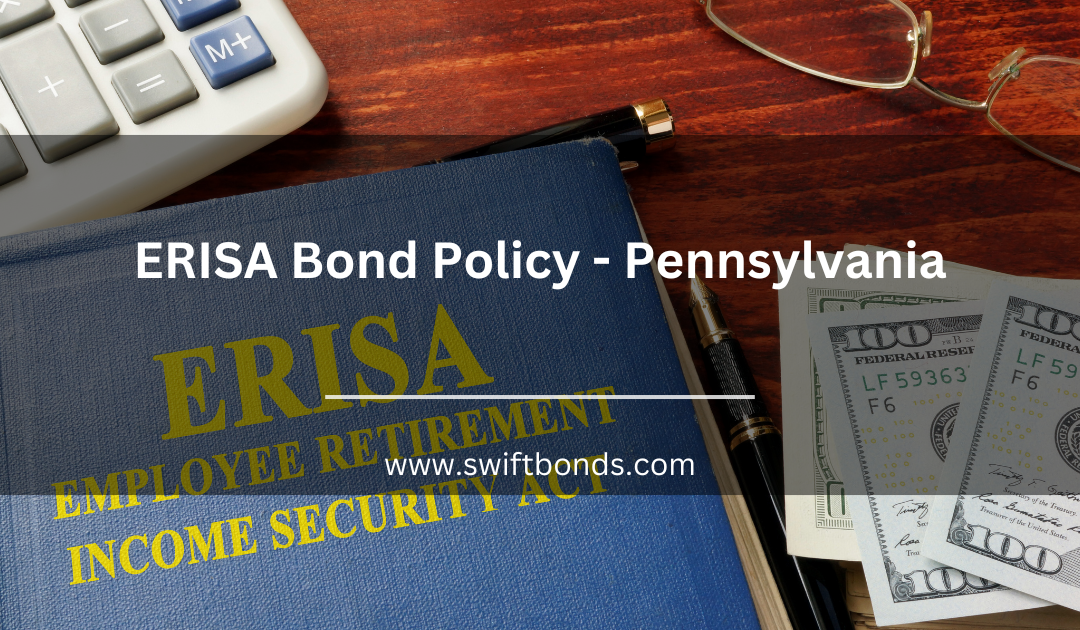Get an Instant Quote on ERISA Bond Policy
Introduction
From our perspective, business owners and plan administrators across Pennsylvania often want clear answers about how to protect employee benefit plans. Many employers, particularly in the construction and skilled trades industries, operate with good intentions but aren’t always aware of the legal responsibilities that come with managing retirement plans, health funds, or other types of employee benefit arrangements. The ERISA Bond Policy – Pennsylvania is one of those obligations that catches many off guard—yet it plays a critical role in protecting the assets of employee benefit plans.
This bond is not optional. It’s a requirement under federal law, as enforced by the U.S. Department of Labor. The Employee Retirement Income Security Act (ERISA) mandates that individuals who handle plan funds—referred to as plan fiduciaries—must be bonded to protect plan participants from financial loss due to fraud or dishonesty. Whether you’re a general contractor overseeing union benefits or a small business owner managing a 401(k), you’re required to carry an ERISA bond.
In Pennsylvania, where union-backed benefit plans are common—such as those tied to the Building Industry Association of Philadelphia and Laborers’ District Council – Fringe Benefits Bond—understanding how ERISA bonds differ from surety or performance bonds is the first step toward staying compliant and avoiding costly penalties.
Common Misunderstandings About ERISA Bonds
We’ve noticed that many employers and administrators confuse an ERISA bond with fiduciary liability insurance or traditional surety bonds. These are not the same. An ERISA bond is a fidelity bond, which means it specifically protects the plan—not the employer—against fraud or misappropriation of funds by people with financial control over those assets. It doesn’t cover administrative mistakes or investment losses. Its focus is purely on dishonest acts like embezzlement or theft.
Another area of confusion comes from who must be bonded. Many assume only third-party administrators need the bond, when in fact any individual with authority to access or manage plan assets may fall under this rule. That includes owners, bookkeepers, or benefits managers. In union-affiliated workplaces, employers may also be obligated to provide bonding in conjunction with other trust fund protections—such as the Township of West Franklin, PA – Road Use Bond when project access intersects with fringe benefit obligations under a collective bargaining agreement.
Failing to carry the bond not only puts plan assets at risk but can also trigger Department of Labor audits and enforcement actions. ERISA bonding is not optional, and failure to comply can have long-term consequences for businesses and their leadership.
Swiftbonds as a Compliance Resource
Based on our experience, Swiftbonds has worked with Pennsylvania employers across multiple sectors to help them meet ERISA bond requirements quickly and correctly. We understand that many businesses are focused on growth, payroll, and project delivery—not federal bonding regulations. That’s where we come in. Our role is to clarify which individuals must be bonded, how much coverage is required, and which plan assets are subject to the rule.
Swiftbonds partners with top-rated surety companies that are approved by the U.S. Department of the Treasury to issue ERISA bonds. These carriers meet all legal requirements and offer policies specifically tailored to pension, health, and welfare plans operating under ERISA.
Our clients include union contractors, manufacturers, and small business owners who need coverage not only for their benefit plans but for additional bonds like the Building Industry Association of Philadelphia and Laborers’ District Council – Fringe Benefits Bond. We offer bundled bonding services where appropriate and support compliance with both federal and local bonding requirements.
Steps to Comply With ERISA Bonding Requirements
What we’ve discovered is that employers who follow a clear process can secure the required bond without confusion or delay.
- Identify which employee benefit plans are covered under ERISA (e.g., 401(k), health reimbursement arrangements, pension plans).
- Determine who has access to or authority over the plan’s assets—including internal employees and third-party administrators.
- Calculate the bond amount, which must be at least 10% of the plan assets handled, with a minimum of $1,000 and a typical maximum of $500,000.
- Contact Swiftbonds to request a quote and complete the application using accurate plan details.
- File proof of bonding with the plan’s Form 5500 and maintain the bond as long as asset handling continues.
Following these steps can help reduce audit risks and show regulators that the plan is in full compliance.
Consequences of Non-Compliance With ERISA
In our observation, failure to obtain or maintain an ERISA bond opens the door to serious enforcement action from the Department of Labor. The agency regularly audits employee benefit plans and reviews filings like Form 5500 to confirm whether a valid ERISA bond is in place. If one is missing or expired, penalties can be assessed, and the plan may be flagged for further investigation.
Beyond regulatory scrutiny, there are reputational and legal risks. If plan funds are misused and no ERISA bond exists, affected participants or their attorneys may pursue civil claims against the employer or fiduciary. This can lead to litigation, settlement costs, or personal liability—especially if the individual involved is an owner or senior executive.
The financial impact of failing to comply is far greater than the small cost of the bond itself. Employers who also work on bonded municipal projects—such as those requiring the Township of West Franklin, PA – Road Use Bond—must be aware that government and union stakeholders view compliance as a baseline for partnership eligibility.
Benefits of ERISA Bond Compliance
We’ve learned that employers who stay ahead of ERISA bonding requirements build stronger, more defensible benefit plans—and earn more trust from their employees. A current bond reflects good governance, transparency, and accountability. These traits matter to union leadership, auditors, and employees alike.
A valid ERISA Bond Policy – Pennsylvania sends a message that the employer takes fiduciary duty seriously. For plan administrators and trustees, the bond offers reassurance that there’s a financial safeguard if any bad actor attempts to misappropriate funds. For business owners, it helps demonstrate compliance during financial audits, benefit plan reviews, and contract bidding processes.
In some cases, bonding is not only a legal safeguard—it’s a contractual one. Many union agreements, like those involving the Building Industry Association of Philadelphia and Laborers’ District Council – Fringe Benefits Bond, contain provisions that link ERISA bonding to continued eligibility for union-backed projects.
Pennsylvania Statutory Framework for ERISA Bonds
ERISA bonding is governed under federal law through the Employee Retirement Income Security Act of 1974 (29 U.S.C. § 1001 et seq.), not Pennsylvania statute. However, Pennsylvania employers must still comply with this federal requirement as enforced by the Department of Labor’s Employee Benefits Security Administration (EBSA).
Bonds must be issued by carriers listed on the Department of the Treasury’s Circular 570, which can be accessed at fiscal.treasury.gov. Plan fiduciaries who handle plan funds must be covered, and the bond amount must equal at least 10% of the value of the assets managed during the plan year.
In Pennsylvania, bonding agents and sureties are regulated by the Pennsylvania Insurance Department, which can be contacted through www.insurance.pa.gov for licensing information and surety compliance. Employers filing Form 5500 must report the bond’s existence and may be asked to produce documentation during an audit.
Employers involved in public projects or union negotiations—such as those managing a Township of West Franklin, PA – Road Use Bond—must often demonstrate that their benefit programs are federally bonded in accordance with ERISA.
Conclusion
We’ve come to appreciate that meeting ERISA bond requirements is one of the most straightforward ways for Pennsylvania employers to demonstrate trustworthiness and legal compliance. Whether you’re handling a union fringe benefit fund or administering a retirement plan, the ERISA Bond Policy – Pennsylvania is a necessary safeguard against fraud and mismanagement.
Swiftbonds works with contractors, manufacturers, and business owners statewide to issue legally compliant ERISA bonds—quickly and professionally. We also assist with related bonds tied to union work, like the Building Industry Association of Philadelphia and Laborers’ District Council – Fringe Benefits Bond, and public access projects such as the Township of West Franklin, PA – Road Use Bond.
Reach out to Swiftbonds today to secure your ERISA bond, reduce compliance risk, and protect your employees’ futures.
Frequently Asked Questions
What does the ERISA Bond Policy cover?
We’ve often noticed confusion about coverage. The ERISA bond protects employee benefit plans from financial loss caused by fraud or dishonesty by individuals handling plan funds. It does not cover investment errors or administrative mistakes.
Who is required to obtain an ERISA bond?
We’ve often noticed questions about who qualifies. Anyone who has access to or authority over plan funds must be bonded. This includes plan fiduciaries, business owners, benefits administrators, and sometimes third-party service providers.
How much coverage is required under ERISA?
We’ve often noticed employers unsure of bond amounts. The required amount is at least 10% of the plan assets handled during the plan year, with a minimum of $1,000 and a general maximum of $500,000, unless otherwise specified by plan type.
Is the ERISA bond the same as fiduciary liability insurance?
We’ve often noticed these two terms confused. No, an ERISA bond covers the plan itself against fraud or theft, while fiduciary liability insurance protects the plan fiduciaries from claims related to errors, breaches of duty, or administrative decisions.
What happens if I fail to obtain an ERISA bond?
We’ve often noticed non-compliance lead to serious issues. Without the bond, your plan is out of compliance with federal law. This can result in DOL audits, fines, and potential legal action if plan assets are misused or unprotected.


